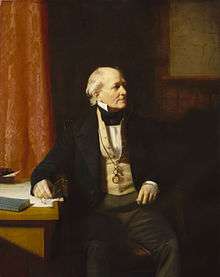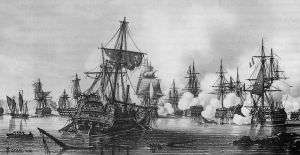HMS Calpe (1800)
| History | |
|---|---|
| Name: | San José |
| Launched: | 1796 |
| Captured: | By the Royal Navy, 27 October 1800 |
| Name: | HMS Calpe |
| Acquired: | By capture, 27 October 1800 |
| Honours and awards: | Naval General Service Medal with clasp "Gut of Gibraltar 12 July 1801"[1] |
| Fate: | Sold, 1802 |
| General characteristics (in Spanish service) | |
| Type: | Polacca |
| Complement: | 34 seamen & 22 soldiers |
| Armament: | 14 guns |
| General characteristics (in British service)[2] | |
| Type: | Sloop-of-war |
| Tons burthen: | 209 (bm) |
| Length: |
|
| Beam: | 26 ft 3 in (8.00 m) |
| Depth of hold: | 12 ft 6 in (3.81 m) |
| Complement: | 49 |
| Armament: |
|
HMS Calpe was the former 14-gun polacca San José of the Spanish Navy, originally built in 1796 in Greece. The British captured her in 1800 and commissioned her as a sloop-of-war. She served at the Battle of Algeciras Bay before the Navy sold her in 1802.
Capture

On 25 October 1800 the frigate Phaeton chased a Spanish polacca to an anchorage under a battery of five heavy guns at Fuengirola, where she joined a French privateer brig. The following night the brig escaped while the polacca tried twice, unsuccessfully, to escape to Málaga. On the night of the 27 October, Francis Beaufort, inventor of the Beaufort Wind-Scale, led Phaeton's boats on a cutting out expedition. Unfortunately the launch, with a carronade, was unable to keep up and was still out of range when a French privateer schooner, which had come into the anchorage unseen, fired on the other boats. The barge and two cutters immediately made straight for the polacca. The boarding party suffered one man killed and three wounded, including Beaufort who received, but survived, 19 wounds.[3] The boarding party succeeded in securing the polacca by 5 am. The captured ship was the San José, alias Aglies, of 14 guns. She had been employed as a packet, carrying provisions between Málaga and Velilla. She had a crew of 34 seamen and there were also 22 soldiers on board. The Spanish sustained at least 13 wounded. The British immediately commissioned San José as a British sloop-of-war under the name of Calpe, the ancient name of Gibraltar. Although it would have been usual to promote Beaufort, the successful and heroic leader of the expedition, to command Calpe, Lord Keith chose Commander George Dundas instead, who not only was not present at the battle, but was junior to Beaufort.[4]
British service
She carried two long 24-pounders in the bow, two long brass 18-pounders for sternchasers, four 12 pounders and four 4-pounders and a crew of 49. When she was first commissioned in the Royal Navy there were insufficient Royal Marines available for her. As a stop-gap, she received a mixed detachment of 22 Army troops from the Gibraltar Garrison, the Royal Artillery, 5th and 63rd Foot, Cambrian Rangers, and the Argyll, Banffshire and Prince of Wales' Own Fencibles, all under the command of an officer from the 5th Foot. Even after the marines arrived, the troops stayed aboard for some more months.[5]
Calpe shared with a number of warships in the capture of Eurydice on 9 February 1801.[6]
Battle of Algeciras Bay
By 1 July 1801 she was at Gibraltar. While there she observed the arrival of a French squadron. On 5 July, at 2 a.m., Lieutenant Richard Janvarin, whom Dundas had dispatched from Gibraltar, joined Rear Adm. James Saumarez in Caesar in a boat, and informed Sir James of the appearance of the French squadron off the Rock.[7]

On 6 July Saumarez sailed from Gibraltar with Caesar, Pompee, Spencer, Venerable, Hannibal and Audacious with the intention of attacking Admiral Linois's squadron of three French line-of-battle ships and a frigate, which were lying a considerable distance from the batteries at Algeciras. As Venerable, the leading ship, approached the wind dropped and she was forced to anchor. Pompee managed to get into action but Hannibal grounded and was forced to strike. Dundas, deceived by a signal from Hannibal, sent his boats to save Hannibal's crew. The French detained the boats and their crews, including Calpe's lieutenant, Thomas Sykes; after firing several broadsides at the enemy's shipping and batteries, Calpe returned to Gibraltar.[8] In the battle the British drove two of the French ships ashore and badly damaged the rest. The total loss in the British squadron was 121 killed, 240 wounded, and 14 missing. The Franco-Spanish force lost 317 men killed and some 3-500 wounded.[8]
On 8 July a squadron of five Spanish ships-of-the-line, a French 74, three frigates and a large number of gunboats reinforced the French ships. Hard work repaired all the British ships at Gibraltar, except Pompee in time for them to follow the Franco-Spanish fleet when it sailed on 12 July. In the subsequent second phase of the Battle of Algeciras Bay, the two first rates Real Carlos and San Hermenegildo fired upon each other during the night, caught fire and exploded, with tremendous loss of life. The British captured the third rate St Antoine, with Superb and Calpe assisting afterwards in securing the prize and removing the prisoners.[9][10] Calpe later shared in the prize money for the St Antoine's hull and provisions,[11] and in the head money for St Antoine, Real Carlos, and San Hermenegildo.[12] Dundas was made Post-captain on 9 August and took command of the St Antoine, which he sailed back to England.
Saumarez then appointed Lieutenant John Lamburn (or Lamborn), first lieutenant of Caesar, to command the Calpe. However, the Admiralty did not confirm Saumarez's promotions, except that of Dundas. Among other decisions, it returned Lamburn to Caesar, and replaced him as captain of Calpe with Commander Phillip Dumaresque. (Dumaresque had been a lieutenant aboard Caesar and received his promotion in July when he arrived in London with Saumarez's dispatches.[13]) In subsequent months Calpe assisted the 38-gun frigate Thames, under Captain Aiskew Paffard Hollis, which had also participated in the battle, in destroying a number of the enemy's coasters in the bay of Estepona.[14] In 1847 the Admiralty issued the Naval General Service Medal with clasp "Gut of Gibraltar 12 July 1801" to all surviving claimants from the battle.
Fate
Calpe was sold in Lisbon in 1802.[2]
Notes
- ↑ The London Gazette: no. 20939. p. 240. 26 January 1849.
- 1 2 Winfield (2008), p.289.
- ↑ In November 1801 the Navy awarded Beaufort a pension of £45 12s. 6d. per annum for his wounds.
- ↑ James (1837) Vol. 3, 55.
- ↑ Haythornthwaite et al., (1993), 52.
- ↑ The London Gazette: no. 16237. p. 348. 14 March 1809.
- ↑ James (1837), 113.
- 1 2 James (1837), 118.
- ↑ The London Gazette: no. 15392. p. 946. 3 Aug 1801.
- ↑ James (1837), 128.
- ↑ The London Gazette: no. 15515. p. 993. 14 Sep 1802.
- ↑ The London Gazette: no. 15669. p. 117. 24 Jan 1804.
- ↑ Ross (2008), 2, 9 and 30.
- ↑ Obituary: Vice Admiral Hollis. The Gentleman's Magazine (1844), 428-30.
References
- Haythornthwaite, Philip J., William Younghusband and Martin Windrow (1993) Nelson's Navy. London: Osprey Publishing. ISBN 978-1-85532-334-6.
- James, William; Frederick Chamier (ed.) (1837) Naval History of Great Britain 1793 - 1827, Vol. 3. London: Richard Bentley
- Ross, John (2008) Memoirs and Correspondence of Admiral Lord de Saumarez, Vol 2. (BiblioLife). ISBN 978-0-559-53469-0.
- Winfield, Rif (2008) British Warships in the Age of Sail, 1793-1817: Design, Construction, Careers and Fates. Seaforth Publishing, 2nd edition. ISBN 978-1-84415-717-4.